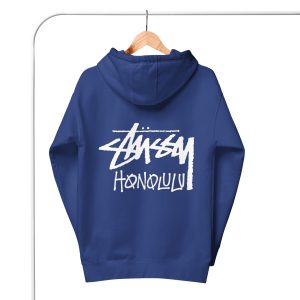
Stüssy, a name synonymous with streetwear and an integral part of the global fashion movement, has come a long way from its humble beginnings. What started as a small surfboard business in the 1980s has blossomed into a worldwide streetwear brand, shaping both skate and surf culture, while influencing high fashion in ways that few could have predicted. This blog Stussy explores the history of Stüssy, tracing its evolution from a surfboard company to the iconic streetwear brand that it is today.
The Birth of Stüssy: Surf Culture Meets Street Fashion
The roots of Stüssy are deeply entrenched in surf culture. The brand was founded in 1980 by Shawn Stüssy, a California native with a passion for surfing. Initially, Stüssy began by crafting custom surfboards in Laguna Beach, California, an area renowned for its surf culture. His boards were unique, featuring a distinct logo designed by Stüssy himself, which quickly gained popularity among local surfers. As surf culture began to gain traction in the mainstream during the early ’80s, Shawn realized that there was an untapped market for clothing that resonated with the laid-back, rebellious attitude of surfers.
In 1984, Stüssy took the next step by printing his logo on T-shirts and other apparel. The brand’s first T-shirt designs were simple yet iconic, featuring Stüssy’s now-famous signature graphic. These shirts quickly gained traction, particularly among surfers and skateboarders who saw the designs as a reflection of their own subcultures. As these items gained popularity, Stüssy began selling them in local stores, further establishing the brand’s presence in surf communities.
The Rise of Streetwear and the Role of Stüssy
As the 1980s progressed, street culture and its intersection with hip-hop, skateboarding, and graffiti began to rise in prominence. While brands like Nike, Adidas, and Converse were already well established in the sportswear world, the idea of creating fashion that spoke directly to youth subcultures was gaining momentum. Stüssy, by this time, had evolved beyond just surf culture and started attracting a broader, more diverse audience, including skateboarders and urban youth.
In the late ’80s and early ’90s, Stüssy began collaborating with local artists and designers to create more urban and bold clothing, capturing the attention of a wider audience. The brand’s graphics grew more experimental, incorporating street art, punk influences, and hip-hop references. This new wave of streetwear resonated with the youth in cities across the United States and Europe, further propelling the brand’s growth.
Collaborations and Expansion Into High Fashion
The 1990s were a pivotal decade for Stüssy. It wasn’t just a surf brand anymore; it had become a force in the burgeoning streetwear scene. During this time, Stüssy began collaborating with some of the most influential names in fashion. These collaborations helped propel the brand into the mainstream and laid the groundwork for streetwear’s eventual crossover into high fashion. One of the most notable collaborations was with the iconic British fashion designer, James Jebbia. In 1994, Jebbia went on to found Supreme, which would go on to become one of the most influential streetwear brands of the 1990s and beyond.
Despite Supreme’s rise, Stüssy remained a dominant force in the streetwear scene, continuously innovating and expanding its product offerings. The brand began selling high-quality streetwear staples like hoodies, sweatpants, and jackets, all adorned with the signature Stüssy logo. It was also during this time that Stüssy became a frequent fixture on the fashion week runways, often blurring the lines between street culture and high fashion. The global appeal of the brand was undeniable, and it was clear that Stüssy had played a major role in the streetwear movement’s rise.
Stüssy in the 21st Century: A Cultural Icon
As the years went by, Stüssy continued to maintain its status as one of the key players in streetwear. By the 2000s and into the 2010s, the brand’s influence expanded far beyond its humble surfboard-making origins. Stüssy became a symbol of youth culture and rebellion, with its designs popping up in high-fashion contexts and being worn by celebrities and musicians alike. At the same time, Stüssy maintained its connection to the surf and skate communities, staying true to its roots while embracing new styles and collaborations.
The brand’s longevity can be attributed to its ability to adapt and Stussy Hoodie evolve while staying true to its core identity. Today, Stüssy’s influence continues to be felt across the fashion world. The brand has collaborated with luxury fashion houses such as Dior and Givenchy, cementing its place as a significant cultural force that transcends traditional streetwear boundaries.
Conclusion
From its humble beginnings as a surfboard company to becoming a global streetwear brand, Stüssy has had a profound impact on the world of fashion. Its legacy is a testament to the power of subcultures in shaping the fashion industry, and the brand has played an integral role in the rise of streetwear as a mainstream fashion category. Through its collaborations, innovative designs, and staying true to its roots, Stüssy has become an indelible part of not just surf and skate culture, but global fashion as a whole. As the brand continues to evolve, it’s clear that Stüssy’s influence will remain a central force in the ongoing development of streetwear and fashion culture for years to come.